1 Introduction
If H.264 is currently the actual overlord of video CODEC, then AAC is the queen of audio CODEC. The mainstream audio and video formats are H.264 with AAC, whether it is a non-real-time media file or a real-time media stream.
2. AAC History
Advanced Audio Coding (AAC) is a lossy compressed audio coding set (in fact, the new coding tool also supports lossless).
Its design goal is to replace the original MP3 coding standard, and hope that the quality is better than MP3 at a similar bit rate as MP3. This goal has been reached and standardized in MPEG-2 and MPEG-4 by ISO and IEC standards organizations.
AAC has been widely supported and applied to various devices and systems YouTube, iPhone, iPod, iPad, Nintendo DSi, Nintendo 3DS, iTunes, DivX Plus Web Player and PlayStation 3. It is supported on PlayStation Vita, Wii (with the Photo Channel 1.1 update installed), Sony Walkman MP3 series and later, Android and BlackBerry, etc.
In 1997, AAC first appeared in the standard MPEG-2 Part 7 (ISO/IEC 13818-7:1997). Similar to the video CODEC standard, AAC has three profiles in MPEG-2 Part 7. They are respectively.
l Low-Complexity profile (AAC-LC / LC-AAC)
l Main profile (AAC Main)
l Scalable Sampling Rate profile (AAC-SSR)
It can be seen from this that AAC-LC appeared the earliest, so AAC-LC is the most widely used and has the best compatibility.
In 1999, AAC upgraded from the original standard and incorporated the standard MPEG-4 Part 3 (ISO/IEC 14496-3:1999)
An important change in this upgrade is the introduction of Audio Object Types (AOT) and the integration of the AOT concept into profiles. At this time, the profiles have also become four.
l Main (which includes most of the MPEG-4 Audio Object Types)
l Scalable (AAC LC, AAC LTP, CELP, HVXC, TwinVQ, Wavetable Synthesis, TTSI),
l Speech (CELP, HVXC, TTSI)
l Low Rate Synthesis (Wavetable Synthesis, TTSI) to synthesize speech.
In 2000, the version was updated to 2, MPEG-4 Audio Version 2 (ISO/IEC 14496-3:1999/Amd 1:2000), the standard defined a new AOT, low delay AAC, the low delay AAC (AAC -LD).
In 2001, the High-Efficiency Advanced Audio Coding (HE-AAC) ISO/IEC 14496-3:2001 was standardized.
In 2003, standardized HE-AAC v2 Profile (AAC LC with SBR and Parametric Stereo) ISO/IEC 14496-3:2005
The current standardized version of AAC is ISO/IEC 14496-3:2009.
From the above standardization history, it can be seen that AAC is not a simple encoder, but a huge collection of audio coding tools.
3. AOT
AOT is the abbreviation of MPEG-4 Audio Object Types. The AOT ID is used for capability set negotiation.
It is precisely because of the many AOTs of AAC that it is difficult to identify users who use AAC.
AAC-LC can be considered as an AAC with an AOT of 2.
The following table is the corresponding table of AOT.
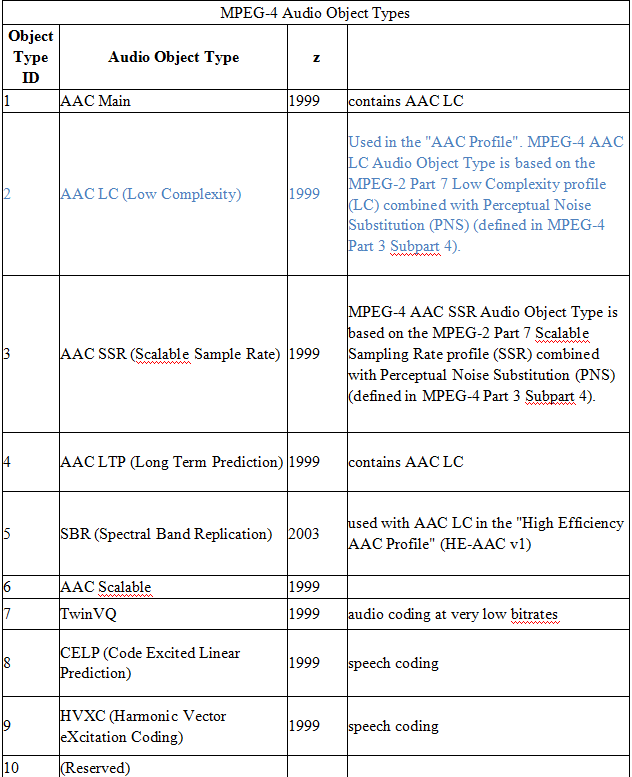
4. MPEG-4 Audio Profiles
The description of the set of audio capabilities in the audio coding direction of MPEG-4 is called Audio Profiles, and the description of audio capabilities is based on AOT.
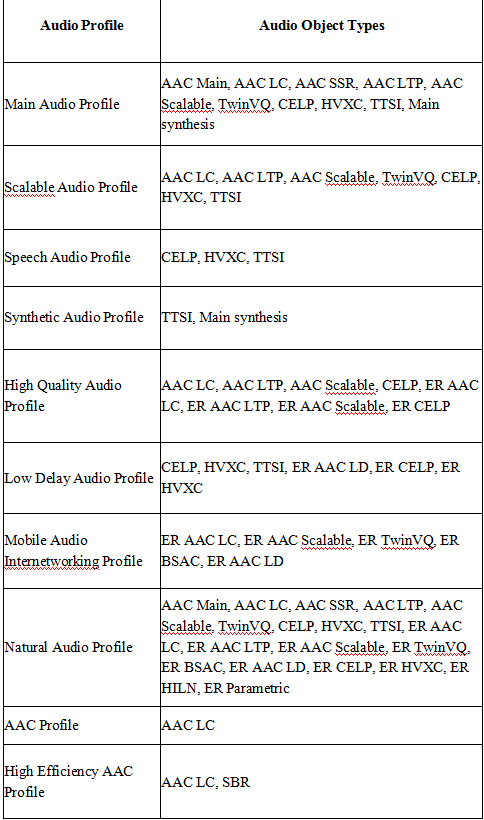
5. AAC-LC
Based on the popularity and importance of AAC-LC, although it is introduced above, it is listed separately here.
Advanced Audio Coding Low-Complexity, (AAC-LC / LC-AAC) format is MPEG-2 format, designed for digital TV. AAC-LC is used when storage space and computing power are limited. This type does not use the two tools of prediction and gain control, and the order of instantaneous noise shaping is relatively low.
AAC-LC makes full use of the psychoacoustic principle. It has the characteristics of incoherence and statistical redundancy in human perception of audio signals. It minimizes the bit data used to express the signal and realizes the rapid and effective compression of audio signals. Pursue the similarity between the output signal and the original signal.
The important technical points of AAC-LC are as follows.
Temporal Noise Shaping: Instantaneous noise shaping is used to control the instantaneous shape of quantization noise and solve the problem of false matching of masking threshold and quantization noise. TNS utilizes time-frequency duality. A signal that is stable in the real-time domain will change drastically in the frequency domain, while a signal that is stable in the frequency domain may change drastically in the time domain. For transient signals in the time domain, the spectral coefficients can be predicted and coded. Predicting the spectral coefficients, the quantizer can be adjusted in time to adapt to the time domain state of the input signal, and the quantization noise can be effectively controlled.
Intensity Stereo: A method of using psychoacoustic principles to improve coding efficiency. Since the human ear is not sensitive to the phase of the high-frequency signal, as long as the energy and frequency spectrum of the signal are similar, there is no difference in perception. Therefore, when the signal correlation of a pair of channels is high, the high-frequency part can be processed to a certain extent , Only encode and transmit data in one channel without affecting the reconstructed sound quality after decoding.
AAC-LC regards 6kHz as the starting frequency of sound intensity stereo processing, and all the sound intensity stereo processing is performed on this frequency. Calculate the energy and total energy of each sub-band of the left and right channels, and then calculate the ratio of the left channel energy to the total energy and convert it into an intensity factor. According to this intensity factor, all the spectrums in the band are summed for the left and right channels. Normalization, the data of the right channel is all set to zero, so that only the left channel data needs to be quantized and coded.
Perceptual Noise Substitution: Perceptual noise substitution is used for spectral components to divide similar noise (the power spectral density is uniform), and artificial noise is used instead. When it is judged that a certain frequency band needs to be replaced by perceptual noise, only the energy of this frequency band is used as a parameter to encode and transmit, without the need to encode the spectrum value in the subband, and the subband energy and random vector generation function are obtained during decoding. Similar to noise.
Middle/Side: Stereo encoding is a method of using the correlation between the signals of a pair of channels to eliminate redundancy and reduce the encoding bit rate. When the AAC-LD encoder has a large correlation between the left and right channel data, Middle=(L+R)/2, Side = (L-R)/2 can be used to replace the left and right channel data for encoding. In this way, the energy is concentrated in one channel of data, while the other channel requires only a few bits of data, which achieves data compression.

5. AAC-LD
Now that I talked about AAC-LC, let’s talk about AAC-LD
AAC is a perceptual audio codec that can provide very high-quality subjective sound quality at a lower bit rate. However, the algorithmic delay of such a codec at low bit rates often exceeds 100ms, so it is not suitable for real-time two-way communication. The G.722-based voice codec scheme is suitable for two-way communication because of its smaller algorithmic delay. However, this kind of speech-based codec can only provide better subjective quality for speech signals, and is not suitable for more complex audio signals. Moreover, even at a very high bit rate, the result of the codec is not good. It is difficult to achieve good sound quality.
The delays of commonly used perceptual audio encoders include:
Framing delay: the block length required for block transformation;
Filterbank delay: Analysis-the delay required by the integrated filter;
Look-ahead delay for block switching: the delay required for block switching to detect transients;
Use of bit reservoir: The delay required for the size of the bit pool relative to the average bit rate.
Total delay calculation formula:

Take the following AAC-LC as an example:
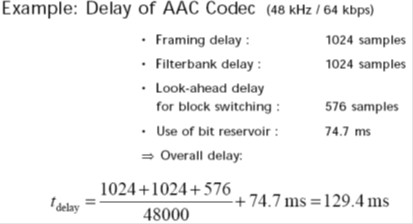
In AAC-LD, in order to reduce the delay, the original 1024 frame length is changed to 512; there is no window switching function, which reduces the forward delay required for window switching; at the same time, to enhance the encoding of transient signals Quality, a window switching mechanism is introduced. The window type includes a general SINE window and a window with less overlap. This window has very little overlap with the following windows. In this way, the TNS tool is optimized to eliminate the transient signal generation. Echo effect.
MPEG-4 Low Delay Audio Coder (AAC-LD) is directly derived from MPEG-2 AAC and combines the low latency requirements necessary for perceptual audio coding and two-way communication. It can guarantee the maximum 20ms algorithmic delay and good sound quality of signals including voice and music. The current MPEG-4 AAC LD supports a maximum sampling rate of 48kHz, and the maximum number of channels is 2 (which can be expanded to multiple channels).
6. AAC package format
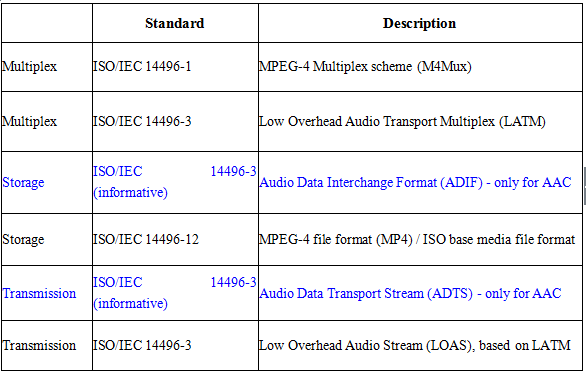
Take two commonly used formats as examples.
ADIF (Audio Data Interchange Format)
ADIF is the AAC audio packaging format specified by MPEG2. The feature of this format is that the start of the audio data can be found deterministically, without the need to start decoding in the middle of the audio data stream, that is, its decoding must be carried out at the clearly defined start. Therefore, this format is commonly used in disk files.
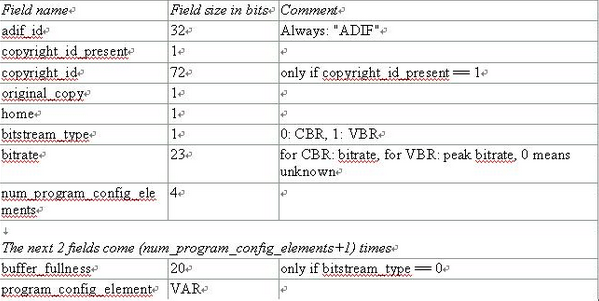
ADTS (Audio Data Transport Stream)
The characteristic of this format is that it is a bit stream with synchronization words, and decoding can start at any position in this stream. Its characteristic is the data stream format.
The purpose of frame synchronization is to find out the position of the frame header in the bit stream. The frame header synchronization word in the aac ADTS format is the 12-bit "1111 1111 1111". The header information of ADTS is composed of two parts, one is fixed header information, tight Next is the variable header information. The data in the fixed header information is the same every frame, while the variable header information is variable from frame to frame.
Fixed header information
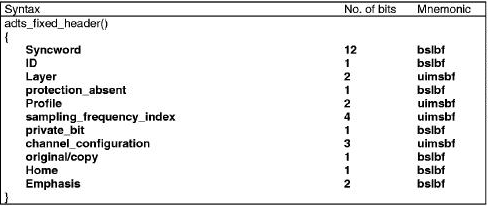
Variable header information

Taken together as the following table
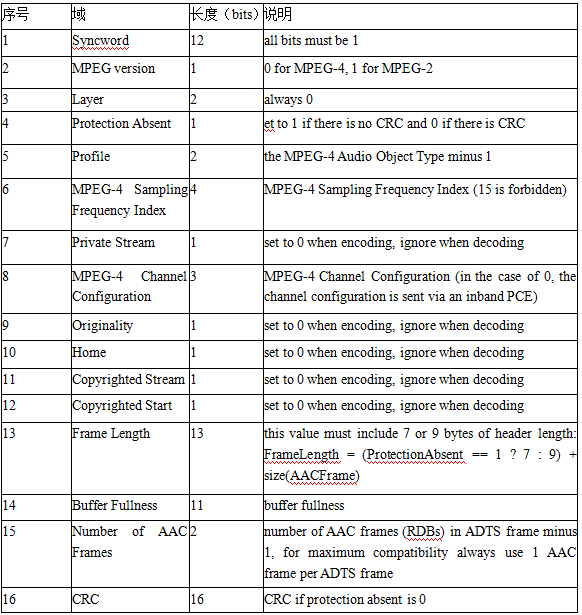
7. AAC copyright and patent license
AAC files and code streams do not involve copyright and patent license issues, so AAC files are easier to legally spread and distribute than MP3 formats. The copyright and patent license of AAC are only for the manufacturers and developers of AAC codec for commercial purposes, so FFMPEG and FAAC and other software containing AAC codec are released in open source form.
AAC's copyright license is a five-year period, and a five-year period can be continued after the expiration of the re-evaluation.
AAC's copyright fee is a one-time entry fee of $15,000, and no annual follow-up fee is required. The entry fee for small businesses can be reduced to $1,000. The definition of a small business is less than 15 employees and an annual income of less than one million dollars.
AAC Licensors
l AT&T Corp.
l Dolby Laboratories, Inc.
l Fraunhofer-Gesellschaft zur Foerderung der angewandten Forschung, e.V.
l Koninklijke Philips N.V.
l Microsoft Corporation
l NEC Corporation
l NTT DOCOMO, INC.
l Orange SA
l Panasonic Corporation
l Telefonaktiebolaget LM Ericsson
8. Finally
What is the format of AAC-LC? What is the difference between AAC and AAC?
AAC is the general term for the set of audio coding standardized in MPEG2 and MPEG4.
AAC-LC is an audio codec with AOT of 2 in the standardized AAC. It is characterized by low computational complexity, small memory footprint, early standardization time, good connectivity, good compatibility, and wide use. The disadvantage is that the algorithm has a high latency, which is not conducive to real-time audio communication.



|
|
|
|
How far(long) the transmitter cover?
The transmission range depends on many factors. The true distance is based on the antenna installing height , antenna gain, using environment like building and other obstructions , sensitivity of the receiver, antenna of the receiver . Installing antenna more high and using in the countryside , the distance will much more far.
EXAMPLE 5W FM Transmitter use in the city and hometown:
I have a USA customer use 5W fm transmitter with GP antenna in his hometown ,and he test it with a car, it cover 10km(6.21mile).
I test the 5W fm transmitter with GP antenna in my hometown ,it cover about 2km(1.24mile).
I test the 5W fm transmitter with GP antenna in Guangzhou city ,it cover about only 300meter(984ft).
Below are the approximate range of different power FM Transmitters. ( The range is diameter )
0.1W ~ 5W FM Transmitter :100M ~1KM
5W ~15W FM Ttransmitter : 1KM ~ 3KM
15W ~ 80W FM Transmitter : 3KM ~10KM
80W ~500W FM Transmitter : 10KM ~30KM
500W ~1000W FM Transmitter : 30KM ~ 50KM
1KW ~ 2KW FM Transmitter : 50KM ~100KM
2KW ~5KW FM Transmitter : 100KM ~150KM
5KW ~10KW FM Transmitter : 150KM ~200KM
How to contact us for the transmitter?
Call me +8618078869184 OR
Email me [email protected]
1.How far you want to cover in diameter ?
2.How tall of you tower ?
3.Where are you from ?
And we will give you more professional advice.
About Us
FMUSER.ORG is a system integration company focusing on RF wireless transmission / studio video audio equipment / streaming and data processing .We are providing everything from advice and consultancy through rack integration to installation, commissioning and training.
We offer FM Transmitter, Analog TV Transmitter, Digital TV transmitter, VHF UHF Transmitter, Antennas, Coaxial Cable Connectors, STL, On Air Processing, Broadcast Products for the Studio, RF Signal Monitoring, RDS Encoders, Audio Processors and Remote Site Control Units, IPTV Products, Video / Audio Encoder / Decoder, designed to meet the needs of both large international broadcast networks and small private stations alike.
Our solution has FM Radio Station / Analog TV Station / Digital TV Station / Audio Video Studio Equipment / Studio Transmitter Link / Transmitter Telemetry System / Hotel TV System / IPTV Live Broadcasting / Streaming Live Broadcast / Video Conference / CATV Broadcasting system.
We are using advanced technology products for all the systems, because we know the high reliability and high performance are so important for the system and solution . At the same time we also have to make sure our products system with a very reasonable price.
We have customers of public and commercial broadcasters, telecom operators and regulation authorities , and we also offer solution and products to many hundreds of smaller, local and community broadcasters .
FMUSER.ORG has been exporting more than 15 years and have clients all over the world. With 13 years experience in this field ,we have a professional team to solve customer's all kinds of problems. We dedicated in supplying the extremely reasonable pricing of professional products & services. Contact email : [email protected]
Our Factory

We have modernization of the factory . You are welcome to visit our factory when you come to China.

At present , there are already 1095 customers around the world visited our Guangzhou Tianhe office . If you come to China , you are welcome to visit us .
At Fair

This is our participation in 2012 Global Sources Hong Kong Electronics Fair . Customers from all over the world finally have a chance to get together.
Where is Fmuser ?

You can search this numbers " 23.127460034623816,113.33224654197693 " in google map , then you can find our fmuser office .
FMUSER Guangzhou office is in Tianhe District which is the center of the Canton . Very near to the Canton Fair , guangzhou railway station, xiaobei road and dashatou , only need 10 minutes if take TAXI . Welcome friends around the world to visit and negotiate .
Contact: Sky Blue
Cellphone: +8618078869184
WhatsApp: +8618078869184
Wechat: +8618078869184
E-mail: [email protected]
QQ: 727926717
Skype: sky198710021
Address: No.305 Room HuiLan Building No.273 Huanpu Road Guangzhou China Zip:510620
|
|
|
|
English: We accept all payments , such as PayPal, Credit Card, Western Union, Alipay, Money Bookers, T/T, LC, DP, DA, OA, Payoneer, If you have any question , please contact me [email protected] or WhatsApp +8618078869184
-
PayPal.  www.paypal.com www.paypal.com
We recommend you use Paypal to buy our items ,The Paypal is a secure way to buy on internet .
Every of our item list page bottom on top have a paypal logo to pay.
Credit Card.If you do not have paypal,but you have credit card,you also can click the Yellow PayPal button to pay with your credit card.
---------------------------------------------------------------------
But if you have not a credit card and not have a paypal account or difficult to got a paypal accout ,You can use the following:
Western Union.  www.westernunion.com www.westernunion.com
Pay by Western Union to me :
First name/Given name: Yingfeng
Last name/Surname/ Family name: Zhang
Full name: Yingfeng Zhang
Country: China
City: Guangzhou
|
---------------------------------------------------------------------
T/T . Pay by T/T (wire transfer/ Telegraphic Transfer/ Bank Transfer)
First BANK INFORMATION (COMPANY ACCOUNT):
SWIFT BIC: BKCHHKHHXXX
Bank name: BANK OF CHINA (HONG KONG) LIMITED, HONG KONG
Bank Address: BANK OF CHINA TOWER, 1 GARDEN ROAD, CENTRAL, HONG KONG
BANK CODE: 012
Account Name : FMUSER INTERNATIONAL GROUP LIMITED
Account NO. : 012-676-2-007855-0
---------------------------------------------------------------------
Second BANK INFORMATION (COMPANY ACCOUNT):
Beneficiary: Fmuser International Group Inc
Account Number: 44050158090900000337
Beneficiary's Bank: China Construction Bank Guangdong Branch
SWIFT Code: PCBCCNBJGDX
Address: NO.553 Tianhe Road, Guangzhou, Guangdong,Tianhe District, China
**Note: When you transfer money to our bank account, please DO NOT write anything in the remark area, otherwise we won't be able to receive the payment due to government policy on international trade business.
|
|
|
|
* It will be sent in 1-2 working days when payment clear.
* We will send it to your paypal address. If you want to change address, please send your correct address and phone number to my email [email protected]
* If the packages is below 2kg,we will be shipped via post airmail, it will take about 15-25days to your hand.
If the package is more than 2kg,we will ship via EMS , DHL , UPS, Fedex fast express delivery,it will take about 7~15days to your hand.
If the package more than 100kg , we will send via DHL or air freight. It will take about 3~7days to your hand.
All the packages are form China guangzhou.
* Package will be sent as a "gift" and declear as less as possible,buyer don't need to pay for "TAX".
* After ship, we will send you an E-mail and give you the tracking number.
|
|
|
For Warranty .
Contact US--->>Return the item to us--->>Receive and send another replace .
Name: Liu xiaoxia
Address: 305Fang HuiLanGe HuangPuDaDaoXi 273Hao TianHeQu Guangzhou China.
ZIP:510620
Phone: +8618078869184
Please return to this address and write your paypal address,name,problem on note: |
|



































